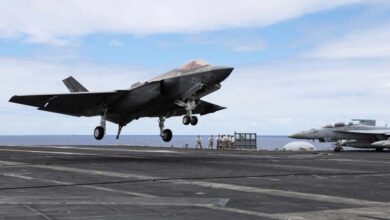J-20s Now Guarding Beijing’s Skies: A Strategic Leap in China’s Air Force Capabilities

In a move that marks a qualitative transformation in China’s airpower, reports confirm that the modern stealth fighter jets J-20 have officially entered service with the air defense forces stationed around Beijing.
-
J-20 Fighters: Beijing under the Protection of the “Phantom”
-
HQ-19: An Advanced Chinese Shield Enters Pakistan’s Defense Calculus
Recent reports confirmed that the Chinese Air Force’s elite 2nd Air Brigade, responsible for guarding the capital, is now operating fifth-generation stealth fighters of the J-20 type.
According to Military Watch Magazine, the brigade is based at Yulong Air Base in Chifeng, Inner Mongolia, under the Northern Theater Command, located about 400 kilometers north of Beijing. Its primary mission is to safeguard the capital’s airspace.
-
China bares its teeth… A major production leap for stealth fighters
-
Chinese J-10C vs. Russian MiG-29M: Which Fighter Jet Is Best for Egypt?
With its advanced capabilities—especially a combat range of around 2,000 kilometers—the J-20 enables the 2nd Air Brigade to conduct extended patrols over Beijing and surrounding regions, significantly enhancing its defensive posture in times of conflict.
This unit is the third combat formation near Beijing confirmed to be equipped with J-20s, after the 172nd Air Brigade stationed at Cangzhou in Hebei Province (which began J-20 operations in February 2018), and the 19th Brigade at Zhangjiakou Air Base, also in Hebei, confirmed operational in February 2025.
-
The Buried Hell… What Is China Hiding Beneath Its Mountains?
-
“Zero Hour” Nuclear Crisis: Where Would the U.S. President Hide?
The deployment of these three brigades creates one of the world’s most formidable fighter-based air defense networks dedicated to protecting China’s capital.
Prior to receiving the J-20s, the 2nd Brigade had relied since 2019 on J-10C lightweight fourth-generation-plus fighters, which offered limited defensive capacity due to their shorter range and smaller radar capabilities.
It is expected that some J-10Cs will remain in service alongside the new J-20s as part of a long-term strategy blending advanced and medium-capability aircraft.
-
Decoding China’s Enigmatic Fighter Jet: A Triple-Power Revolution in the Sky
-
“The White Emperor”: Discover China’s Revolutionary Sixth-Generation Fighter
Thanks to its exceptional range—the longest of any current fighter jet—the J-20 will likely extend the 2nd Brigade’s mission far beyond defending Beijing. This could include operations in critical areas such as the East China Sea and the Sea of Japan, particularly over contested zones like the Diaoyu/Senkaku Islands and the Korean Peninsula.
Although J-20 production is progressing rapidly—estimated at around 120 aircraft annually—this pace may slow in the early 2030s as China prepares to introduce two sixth-generation fighter types, unveiled in December 2024 and now undergoing flight testing.
-
Facing China and U.S. Ambiguity.. Japan Rebuilds Its Military Power
-
UK Reinforces Its Defenses with Nuclear Submarines: Largest Military Overhaul Since the 1990s
As the U.S. remains several years behind in developing its own sixth-generation jet, questions are being raised about the future of the F-35 program and its impact on the regional power balance in the East China Sea, near the 2nd Brigade’s operational area.
With J-20 production scaling up significantly, some projections estimate the total fleet could surpass 1,000 aircraft. It is therefore expected that additional fighter brigades near Beijing and the East China Sea will soon transition to this advanced platform.
The pace of J-20 acquisition has outstripped all other fighter jet programs globally. In comparison, the U.S. Air Force’s purchases of F-35s represent only 20 to 40 percent of China’s annual acquisition rate for its flagship stealth aircraft.
-
India-Pakistan Escalation: China Offers Mediation.. US Secures Its Diplomatic Mission
-
A Nuclear-Proof Facility Ten Times Bigger Than the Pentagon… Discover China’s “Fortress”
-
The Eastern Influence and the BRICS Bloc: How China and Arab Countries Prevailed at the G20 Summit?
-
Italy warns against Tunisia falling into the hands of Russia and China
-
Ukraine crisis tests China-Russia partnership
-
The Technological Revolution and Irregular Warfare: Why is China Surpassing the U.S.?












